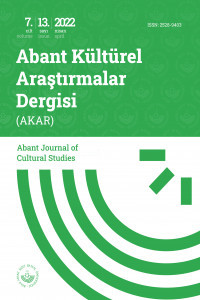Transmedya hikâye anlatıcılığı: Kötü Çocuk örneği
Transmedya hikâye anlatıcılığı, anlatı, Wattpad, internet, sinema, medya platformu
Transmedia storytelling: Kötü Çocuk case
Transmedia storytelling, narrative, Wattpad, internet, cinema, media platform,
___
- Bolin, Göran (2007) Media Technologies, Transmedia Storytelling and Commodification. Ambivalence Towards Convergence: Digitalization and Media Change, Ed. Tanja Storsul and Dagny Stuedahl, p. 237-248. Sweden: Nordicom.
- Box Office (2017) https://boxofficeturkiye.com/yillik/?yil=2017&yilop=tum Erişim Tarihi 14.08.2017.
- Daryoosh, Hayati (2012) Transmedia Storytelling: A Study of the Necessity, Features and Advantages. International Journal of Information and Education Technology, 2 (3): 196-199.
- Dönmez, Mevlüt; Güler, Şakir (2016) Transmedya Hikâyeciliği “Doritos Akademi” Örneği İncelemesi. Süleyman Demirel Üniversitesi Vizyoner Dergisi, 7(16): 155-175.
- Evans, Elizabeth (2011) Transmedia and Television: Audiences, New Media and Daily Life, UK: Routledge.
- Giovagnoli, Max (2011) Transmedia Storytelling: Imagery, Shapes And Techniques, Trans. Feny Montesano - Piero Vaglioni. Max Giovagnoli & ETC Press.
- Grandío, María del Mar; Bonaut, Joseba (2012) Transmedia Audiences and television Fiction: A Comparative Approach Between Skins (UK) and El Barco (Spain). Journal of Audiences & Reception Studies, 9 (2): 558-574.
- Jenkins, Henry (2016) Cesur Yeni Medya: Teknolojiler ve Hayran Kültürü, Çev. Nihan Yeğengil. İstanbul: İletişim.
- Kalogeras, Stavroula (2014) Transmedia Storytelling and the New Era of Media Convergence in Higher Education, UK: Palgrave Macmillan.
- Philips, Andrea (2012) A Creator’s Guide to Storytelling Transmedia, USA: McGraw-Hill.
- Scolari, Carlos Alberto (2009) Transmedia Storytelling: Implicit Consumers, Narrative Worlds, and Branding in Contemporary Media Production. International Journal of Communication, 3: 586-606.
- Thon, Jan-Noël (2016) Transmedial Narratology and Contemporary Media Culture, Lincoln and London: University of Nebraska Press.
- Wattpad (2017) https://www.wattpad.com/ Erişim Tarihi: 10.08.2017.
- Vini Uehara'nın Denim Günlüğü | Mavi (2017) https://www.youtube.com/watch?v=P4ATTGtK64I Erişim tarihi: 06.08.2017.
- Yayın Aralığı: Yılda 2 Sayı
- Başlangıç: 2016
Görsel hazzın dişil örüntüleri: Mavi Kod (Code Blue)
Tüketim kültüründe etkili bir araç olarak reklamın işlevlerine dair genel bir değerlendirme
Konfüçyüsçülük’teki Tian kavramının incelenmesi
Türk basın tarihinde taşrada yayınlanan bir merkez gazetesi: Ülke
Transmedya hikâye anlatıcılığı: Kötü Çocuk örneği
Tüketim kültürü bağlamında yazılı basında hafta sonu ekleri
Roma Dönemi cam kaplarında temenni yazıtları
Erving Goffman: Günlük Yaşamda Benliğin Sunumu (Kitap eleştirisi)
